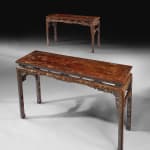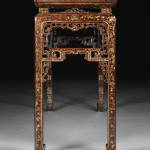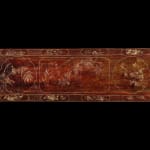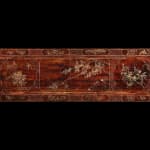A PAIR OF CHINESE BROWN AND GILT LACQUER TIAOZHUO
W: 55.5” / 141cm
D: 17.5” / 44cm
Further images
Provenance
Private collection: London, UK
Literature
Michel Beurdeley, Chinese Furniture (Kodansha International, 1979), fig. 182
‘The Complete Collection of Treasures of the Palace Museum, Furniture of the Ming and Qing Dynasties (II)’, no. 54, The Commercial Press (Hong Kong, 2002), pl. 89
COMPARE
Example in The Palace Museum Collection, Beijing, illus. Hu Desheng, The Palace Museum Collection: A Treasury of Ming & Qing Dynasty Palace Furniture, Volume I, trans. Curtis Evarts (Beijing, 2007), pp. 220-21, fig. 245
A pair of Qing, Dynasty, Qianlong Period brown and gilt-lacquer tiaozhuo, the rectangular tops with depictions of flower sprays and birds and butterflies amongst blooms, flowering plants and branches within shaped panels on fretwork and diapers grounds, above a waisted friezes pierced with elliptical openings, each containing open fretwork, above aprons decorated with floral tracery issuing leaves, lotus plants, camellia flowers and dahlia blooms and pierced fretwork corner brackets, raised on chamfered legs joined with openwork stretchers, similarly decorated in a dark brown lacquer with gilded designs on a red base, to create a rich, tri-colour surface
The tables are in wonderful, original condition and retain an exceptional colour and patination throughout.
The Qianlong period (1735-1795) was the zenith of Chinese artistic and cultural production. During this time, the flowering of the arts that had occurred under the previous emperors Kangxi (1661-1722) and Yongzheng (1722-1735) reached its height as architecture, painting, porcelain, jade and ivory work flourished with a final brilliance before later Chinese artisans produced increasingly for the export market.
The Qianlong period was the highpoint of lacquer wood furnishings such as the present tables. Introduced and popularised under Qianlong’s father, Emperor Yongzheng, they often combined lively foliate motifs, as on the present pair, reflecting the assimilation into Chinese design of the European Rococo brought to the imperial Qing Court by Jesuit missionaries.
Emperor Qianlong himself was greatly immersed in the arts. He practised calligraphy, Chinese painting and was a keen essayist and poet, publishing over 1,300 pieces of prose and 40,000 poems which he added as inscriptions to the paintings and historical artworks in his principal residence, The Palace of Tranquil Longevity in the Forbidden City. Qianlong wrote more poetry in his lifetime than all the poets of the golden age of poetry in China, the Tang Dynasty (618-906), combined and is one of the most prolific writers of all time.
Qianlong collected art assiduously, acquiring the great private collections of the seventeenth century and reintegrating them into the Imperial Collection, undertaking vast projects to preserve and restore Chinese heritage and Confucian culture. Most of the several thousand jade items in the imperial collection date from his reign and his especial interest in ancient bronzes, bronze mirrors, seals, pottery, ceramics and enamels, metal and lacquer works prompted him to document these collected works in comprehensive, lavish catalogues.
Embracing the arts of other cultures, namely those European, Japanese and Indian, Qianlong received missionaries and artists Giuseppe Castiglione and Jean-Denis Attiret at court and inflected Chinese art with imported styles. He amassed a great collection of European clocks, which he had copied in his court workshops, and at Yuanmingyuan Palace near Beijing, where over the course of his reign he came to reside more and more, he increased the estate and erected new buildings in the European manner. At his request, several Jesuits built residences and gardens in modified Italian Baroque and Rococo styles around fountains like those of Versailles in France.
With their exceptional quality and ornate design, it is entirely possible that this pair of tiaozhuo adorned the interior of a Qianlong imperial palace, if not at Yuanmingyuan then the Forbidden City.









